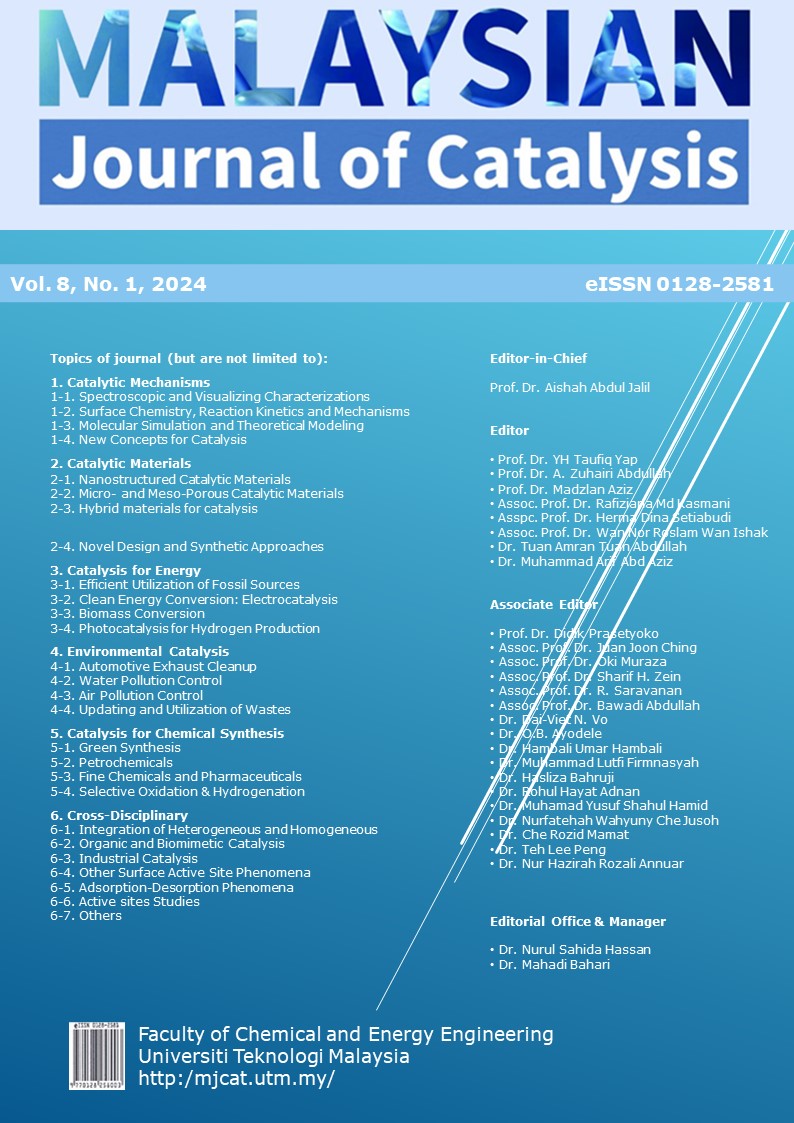Direct Alcoholysis of Glucose into Alkyl Levulinates Catalysed by Metal-Doped Sulfonated Activated Carbon
DOI:
https://doi.org/10.11113/mjcat.v8n1.186Keywords:
alkyl levulinate; Brønsted-lewis; alcoholysis; sulfonated activated carbon; metal dopingAbstract
Lignocellulosic biomass is widely studied to produce alkyl levulinate through alcoholysis catalysed by acid catalyst, which potentially used as a biofuel additive. However, the poor properties of homogeneous catalyst have prompted this study to focus on enhancing the yield of alkyl levulinate by using sulfonated activated carbon (AC-S) doped with different metals as a heterogeneous catalyst with co-existence of Brønsted and Lewis acidic sites. The activated carbon (AC) precursor was modified via sulfonation and impregnated with iron (Fe), copper (Cu) and cobalt (Co) metals, which were further characterised to evaluate their physicochemical properties as a catalyst. Their catalytic activity was evaluated for glucose alcoholysis in a stainless-steel batch reactor at 180 ˚C for 4 h, by charging 0.6 g of glucose, 40 mL of alcohol (methanol and ethanol) and 0.3 g of catalyst. From the result, the catalyst properties were improved after sulfonation and metal doping. Among the employed heterogeneous catalysts, AC-S-Cu exhibited the highest catalytic activity, which was contributed mainly by its co-existence of Brønsted and Lewis acidic sites with significant Brønsted acidity, higher thermal stability with minimum weight loss up to 200 ˚C (<2 wt%), better morphology, and larger surface area (928 m2/g). The maximum alkyl levulinate yield (15.04 wt%) was obtained for ethyl levulinate production under conditions of 180 ˚C, 4 hr, 0.6 g of glucose, 0.3 g of AC-S-Cu and 40mL of ethanol. The outcome of this study provides an insight on the potential of AC-S-Cu in facilitating the direct alcoholysis of glucose to alkyl levulinate

Downloads
Published
How to Cite
Issue
Section
License

This work is licensed under a Creative Commons Attribution-NonCommercial 4.0 International License.
The Malaysian Journal of Catalysis publishes open access articles under the terms of the Creative Commons Attribution (CC BY) License which permits use, distribution and reproduction in any medium, provided the original work is properly cited.Â
The Department of Chemistry, Faculty of Science, UTM retains the Copyright on any research article published by Malaysian Journal of Catalysis.
Authors grant Malaysian Journal of Catalysis a license to publish the article and identify itself as the original publisher.















